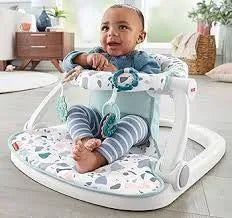As a parent, you're always looking for ways to help your little one reach those exciting developmental milestones safely and comfortably. Enter the sit me up floor seat – a game-changing piece of baby gear that's become a must-have for families everywhere. But if you're new to this handy contraption, you might be wondering: "How exactly do I use this thing?"
Don't worry, we've got you covered! Let's dive into everything you need to know about sit me up floor seats.
Prefer to watch a video on how to use and care for a Sit Me Up Floor Seat instead? Watch our instructional video at https://www.youtube.com/shorts/x24E3fQMNDk
What Exactly Is a Sit Me Up Floor Seat?
A sit me up floor seat is a supportive, portable seat designed to help babies who can't quite sit up independently yet. Think of it as training wheels for sitting! These seats typically feature a wide, stable base, supportive back and sides, and often come with fun toys or activity trays to keep your little one entertained.
When Can Your Baby Start Using One?
The sweet spot is typically between 3-6 months, but every baby develops at their own pace. Here are the key signs your baby is ready:
- Can hold their head up steadily
- Shows interest in sitting up
- Has some trunk control (even if wobbly)
- Weighs at least 10-15 pounds (check your specific seat's requirements)
Important note: Always consult your pediatrician before introducing any new baby gear, especially if your little one was born prematurely or has any developmental concerns.
Step-by-Step: How to Use a Sit Me Up Floor Seat
1. Choose the Right Location
- Place on a flat, stable surface away from stairs, furniture edges, or anything your baby could grab
- Ensure there's plenty of space around the seat
- Never use on elevated surfaces like tables or counters
2. Check the Seat Before Each Use
- Inspect for any damage, loose parts, or wear
- Ensure all locks and mechanisms are working properly
- Clean the seat if needed
3. Getting Baby Settled
- Gently lower your baby into the seat, supporting their back and head
- Make sure their bottom is positioned correctly in the seat
- Adjust any straps or safety features according to manufacturer instructions
- Ensure baby's feet can touch the floor or footrest comfortably
4. Safety First
- Never leave your baby unattended – this cannot be stressed enough!
- Keep sessions short (15-20 minutes max) to prevent overstimulation or strain
- Watch for signs of fatigue or fussiness
Pro Tips for Maximum Success
Start Slow: Begin with just 5-10 minutes and gradually increase as your baby gets comfortable.
Timing Matters: Use the seat when your baby is alert and happy, not when they're tired or hungry.
Engage and Interact: Don't just plop them down and walk away – play, sing, or read together!
Rotate Toys: Keep things interesting by switching out toys or activities regularly.
Follow Baby's Cues: If they seem uncomfortable or fussy, it's time for a break.
Common Mistakes to Avoid
❌ Using it as a babysitter – Always supervise your baby ❌ Exceeding time limits – Too much time can actually hinder natural development ❌ Starting too early – Wait until your baby shows readiness signs ❌ Ignoring weight limits – These exist for safety reasons ❌ Using on uneven surfaces – Stability is key
Cleaning and Maintenance
Most sit me up floor seats have removable, machine-washable fabric components. Here's how to keep yours in tip-top shape:
- Wipe down plastic parts with baby-safe cleaner
- Remove and wash fabric pieces according to care instructions
- Check and tighten any loose screws or connections regularly
- Store in a dry place when not in use
When to Transition Out
Your baby will outgrow their sit me up floor seat when they:
- Can sit independently without support
- Exceed the weight limit
- Show signs of wanting to crawl or move around more
- Seem frustrated or confined by the seat
This typically happens around 6-9 months, but again, every baby is different!
The Bottom Line
A sit me up floor seat can be a wonderful tool for helping your baby develop sitting skills while keeping them entertained and engaged. The key is using it safely, appropriately, and as part of a balanced approach to your baby's development – not as a replacement for floor time, tummy time, or good old-fashioned parent interaction.
Remember, these seats are meant to support development, not rush it. Let your baby set the pace, stay engaged during use, and always prioritize safety over convenience.

